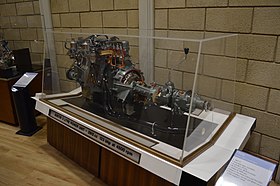This article needs additional citations for verification. (February 2017) |
| BMC C-Series Engine | |
|---|---|
 | |
| Overview | |
| Manufacturer | British Motor Corporation |
| Production | 1954 - 1971 |
| Layout | |
| Configuration | OHV Inline-6 |
| Displacement | 2.6 L; 161.0 cu in (2,639 cc) 2.9 L; 177.7 cu in (2,912 cc) |
| Cylinder bore | 79.4 mm (3.13 in) (2.6 L) 83.4 mm (3.28 in) (2.9 L) |
| Piston stroke | 88.9 mm (3.50 in) |
| Cylinder block material | Cast Iron |
| Cylinder head material | Cast Iron |
| Valvetrain | OHV, Duplex Chain drive |
| Combustion | |
| Fuel system | 1, 2 or 3 Carburettor(s) |
| Fuel type | Petrol |
| Cooling system | Water-cooled |
| Output | |
| Power output | 63 kW (86 PS; 84 hp)→76 kW (103 PS; 102 hp) (2.6 L) 76 kW (103 PS; 102 hp)→112 kW (152 PS; 150 hp) (2.9 L) |
| Dimensions | |
| Dry weight | 1954-1967: 271 kg (597 lb) 1967-1971: 251 kg (553 lb)[1] |
| Chronology | |
| Predecessor | Austin D-Series engine |
| Successor | BMC E-Series engine |

The BMC C-Series is a straight-6 automobile engine produced from 1954 to 1971. Unlike the Austin-designed A-Series and B-Series engines, it came from the Morris Engines drawing office in Coventry and therefore differed significantly in its layout and design from the two other designs which were closely related. This was due to the C-Series being in essence an enlarged overhead valve development of the earlier 2.2 L Straight-6 overhead camshaft engine [2] used in the post-war Morris Six MS and Wolseley 6/80 from 1948 until 1954, which itself also formed the basis of a related 1.5 L 4-cylinder engine for the Morris Oxford MO in side-valve form and the Wolseley 4/50 in overhead camshaft form. Displacement was 2.6 to 2.9 L with an undersquare stroke of 88.9 mm (3.50 in), bored out to increase capacity.
- ^ "Engines : C-Series - AROnline". 26 August 2011.
- ^ Pressnell, Jon (2013). Morris: The Cars and the Company. United Kingdom: J H Haynes & Co Ltd. p. 227. ISBN 978-1859609965.